-
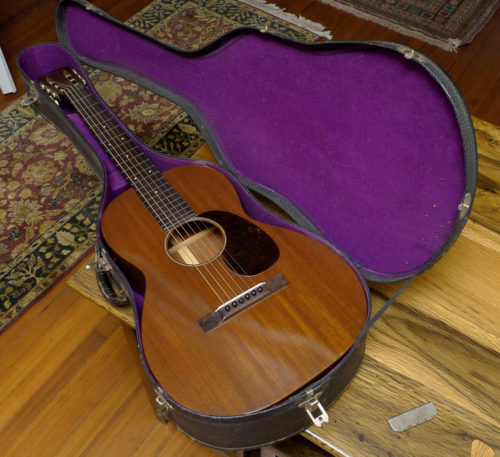 If there is a better-preserved Martin guitar from 1937, we have not seen it. This instrument is as an almost time-capsule condition 0-17H, still in its original case. And of course with its original Hawaiian set up. Many people convert these pre-war Martin Hawaiian set up guitars, to “Spanish” style, i.e. regular steel-string flat top set up. And that is certainly an option for whoever acquires this instrument. But this example, is just too nice, and too original for us to want to convert it. And the tone is exquisite (On request, we’ll send you a link to a video/audio clip of one of this country’s best, most famous dobro/pedal steel players playing slide on this great Martin 0-17H, right here in our shop.) All mahogany of course: mahogany back, sides, and top. Brazilian rosewood bridge, and fretboard. The guitar has no play wear. We won’t call it pristine– even under-the bed-guitars that have not really been played, have a few nicks from just being in the case and moved around a couple of times in 70+ years. But it’s as close to perfect as you’ll find in any 1930’s Martin. The neck is straight as an arrow, showing no bowing at all. No cracks of any kind. All original parts, period– down to the nut, bridge pins, and ivory saddle. The guitar is 12 fret to the body, unlike the regular 0-17’s from this period that were 14-fret.
If there is a better-preserved Martin guitar from 1937, we have not seen it. This instrument is as an almost time-capsule condition 0-17H, still in its original case. And of course with its original Hawaiian set up. Many people convert these pre-war Martin Hawaiian set up guitars, to “Spanish” style, i.e. regular steel-string flat top set up. And that is certainly an option for whoever acquires this instrument. But this example, is just too nice, and too original for us to want to convert it. And the tone is exquisite (On request, we’ll send you a link to a video/audio clip of one of this country’s best, most famous dobro/pedal steel players playing slide on this great Martin 0-17H, right here in our shop.) All mahogany of course: mahogany back, sides, and top. Brazilian rosewood bridge, and fretboard. The guitar has no play wear. We won’t call it pristine– even under-the bed-guitars that have not really been played, have a few nicks from just being in the case and moved around a couple of times in 70+ years. But it’s as close to perfect as you’ll find in any 1930’s Martin. The neck is straight as an arrow, showing no bowing at all. No cracks of any kind. All original parts, period– down to the nut, bridge pins, and ivory saddle. The guitar is 12 fret to the body, unlike the regular 0-17’s from this period that were 14-fret. -
Out of stock
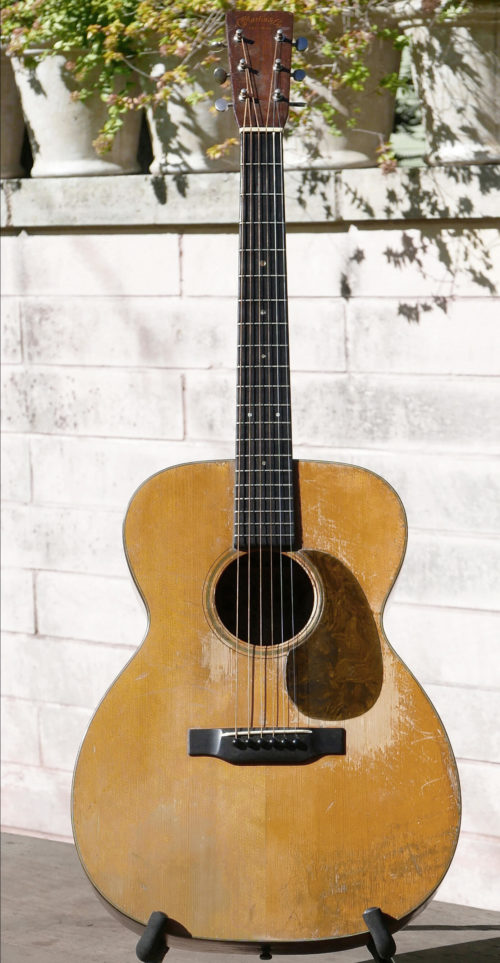 Impossible to mistake this guitar for a “1937 Authentic” or some such “recreation”. This 000-18 left the Martin factory in Nazareth, in 1937, indeed. And it’s been well-played since. More importantly, the tone is stellar– all you would expect from this style, this year, and more. Its bass response is similar to the best prewar D-18s. And it has the unmistakable string separation that only prewar Martins have. This instrument was in the family of its original owner until we obtained it. The original owner was Leroy Jenkins, a blind country artist in the 1950’s, in Texas, on the Dude label.
Impossible to mistake this guitar for a “1937 Authentic” or some such “recreation”. This 000-18 left the Martin factory in Nazareth, in 1937, indeed. And it’s been well-played since. More importantly, the tone is stellar– all you would expect from this style, this year, and more. Its bass response is similar to the best prewar D-18s. And it has the unmistakable string separation that only prewar Martins have. This instrument was in the family of its original owner until we obtained it. The original owner was Leroy Jenkins, a blind country artist in the 1950’s, in Texas, on the Dude label. -
 Nothing sounds like a 30’s Gibson L-00. No longer a sleeper on the vintage guitar market–they are sought after by working musicians the world over¬–they are still under-rated on the collector market. These mid-size Gibsons are incredibly resonant. There is nothing like them, from Gibson, and the mid-size Adirondack spruce over mahogany Martins from the mid to late 30’s command more than twice the price. This L-00 from 1938 has the best tone of any of the 30’s L-00’s we’ve seen. You won’t believe its presence. Acquired by us from the family of the original owner in Austin, Texas, this guitar is a great example of the era when Gibson still had a production jump on Martin, and even its lower cost guitars were winning the marketing war at the trailing end of the depression. This L-00 had a re-spray of its burst in the early 60’s, so while not the original finish, it’s got the right look and feel of the 30’s, and plenty of mileage to make it more than convincing. The top and sides are completely crack-free, and there are only two small cracks on the back. One is not through the wood, and the other was expertly addressed by Tony Nobles with a small cleat. Tony also made a new perfect reproduction Brazilian Rosewood bridge. The bridge plate is original and in great condition. Original firestripe pickguard. Original nut. The non-original tuners on the instrument when we acquired it were replaced by us with klusons from the period. Tony also installed new T-frets. While we tend to specialize in vintage Martins, this one might change my mind.
Nothing sounds like a 30’s Gibson L-00. No longer a sleeper on the vintage guitar market–they are sought after by working musicians the world over¬–they are still under-rated on the collector market. These mid-size Gibsons are incredibly resonant. There is nothing like them, from Gibson, and the mid-size Adirondack spruce over mahogany Martins from the mid to late 30’s command more than twice the price. This L-00 from 1938 has the best tone of any of the 30’s L-00’s we’ve seen. You won’t believe its presence. Acquired by us from the family of the original owner in Austin, Texas, this guitar is a great example of the era when Gibson still had a production jump on Martin, and even its lower cost guitars were winning the marketing war at the trailing end of the depression. This L-00 had a re-spray of its burst in the early 60’s, so while not the original finish, it’s got the right look and feel of the 30’s, and plenty of mileage to make it more than convincing. The top and sides are completely crack-free, and there are only two small cracks on the back. One is not through the wood, and the other was expertly addressed by Tony Nobles with a small cleat. Tony also made a new perfect reproduction Brazilian Rosewood bridge. The bridge plate is original and in great condition. Original firestripe pickguard. Original nut. The non-original tuners on the instrument when we acquired it were replaced by us with klusons from the period. Tony also installed new T-frets. While we tend to specialize in vintage Martins, this one might change my mind. -
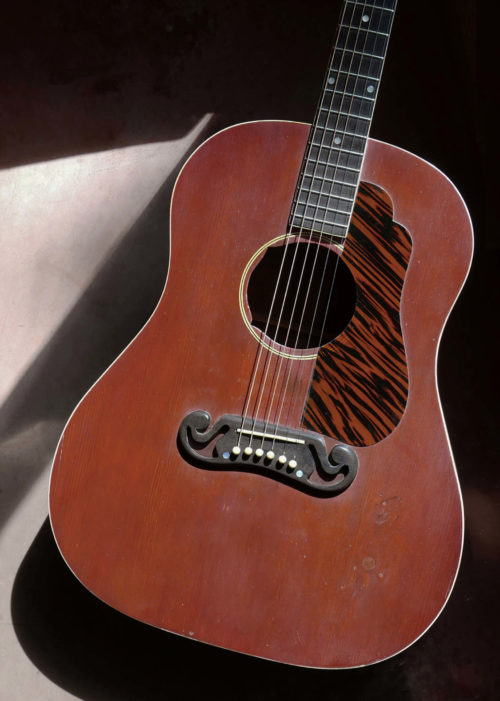 This is not your father’s J-55. And it’s not a $20K guitar. It is a wonderful player. This is an original 1939 Gibson Jumbo 55, also called the “J-55”, serial # EA5652. It is the rare, stair step headstock model, only made for a brief window in the late 30’s. It delivers the trademark, large body, prewar, long scale Gibson tone, like no other. It plays beautifully, with original bridge, frets, braces. This guitar has of course the original, Mustache bridge, and more rare– the stair step headstock. Original bridge plate. Original binding including on fretboard. Original pearl logo on the headstock (with original finish). The pickguard is a nitro cellulose reproduction meticulously crafted in our shop. It has the long scale, 25 ½ inches, that makes this model so great. And a little-known original feature of this rare model is that it has a 1 11/16 nut width, that combined with the low action makes it effortless to play, and with tone that cannot be equaled in any postwar Gibson. The intonation is spot-on, and the intonation and fretting/action are great even at the high fret positions. It was refinished in a deep Gibsonesque red, decades ago– and that makes this guitar the most affordable true 1939, stairstep headstock J-55 you will ever find. (Top thickness is fine, there was no thinning in the past). The tone is superb. And the action is superb– low and fast without sacrificing tone or volume at all.
This is not your father’s J-55. And it’s not a $20K guitar. It is a wonderful player. This is an original 1939 Gibson Jumbo 55, also called the “J-55”, serial # EA5652. It is the rare, stair step headstock model, only made for a brief window in the late 30’s. It delivers the trademark, large body, prewar, long scale Gibson tone, like no other. It plays beautifully, with original bridge, frets, braces. This guitar has of course the original, Mustache bridge, and more rare– the stair step headstock. Original bridge plate. Original binding including on fretboard. Original pearl logo on the headstock (with original finish). The pickguard is a nitro cellulose reproduction meticulously crafted in our shop. It has the long scale, 25 ½ inches, that makes this model so great. And a little-known original feature of this rare model is that it has a 1 11/16 nut width, that combined with the low action makes it effortless to play, and with tone that cannot be equaled in any postwar Gibson. The intonation is spot-on, and the intonation and fretting/action are great even at the high fret positions. It was refinished in a deep Gibsonesque red, decades ago– and that makes this guitar the most affordable true 1939, stairstep headstock J-55 you will ever find. (Top thickness is fine, there was no thinning in the past). The tone is superb. And the action is superb– low and fast without sacrificing tone or volume at all. -
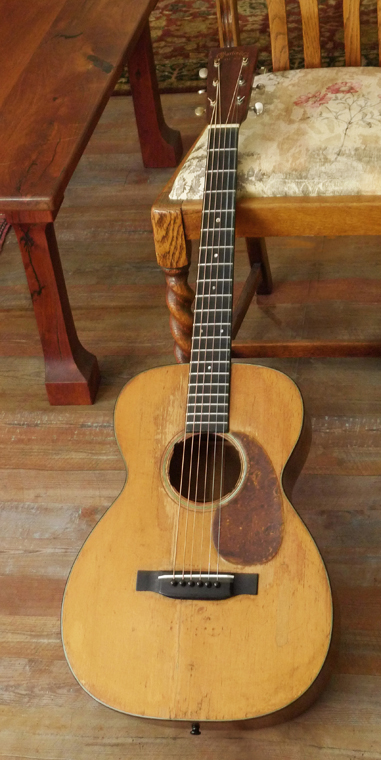 This guitar is probably among the first twenty Martins made in 1939 after the change in nut width on 14-fret models from 1 3/4" to 1 11/16", so yes it is 1 11/16. It has all original finish. Original tuners. Original maple bridge plate. It has multiple repaired cracks on top and sides (no cracks on back). Extensive play wear. New, but perfect, historically correct reproduction Ebony bridge.
This guitar is probably among the first twenty Martins made in 1939 after the change in nut width on 14-fret models from 1 3/4" to 1 11/16", so yes it is 1 11/16. It has all original finish. Original tuners. Original maple bridge plate. It has multiple repaired cracks on top and sides (no cracks on back). Extensive play wear. New, but perfect, historically correct reproduction Ebony bridge. -
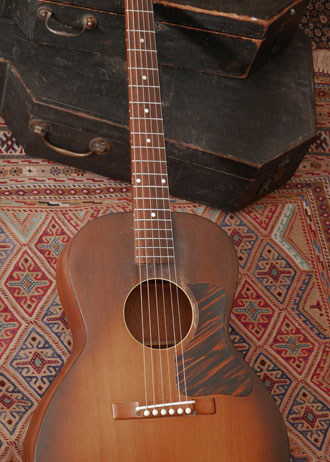 Read the full description below. If you're interested in this guitar, please call 512.922.8596 or contact us here.
Read the full description below. If you're interested in this guitar, please call 512.922.8596 or contact us here. -
 We called it the “Tony Rice” prewar 000-18. Is it the "tony rice" style slightly enlarged soundhole (done decades ago). All original finish.
We called it the “Tony Rice” prewar 000-18. Is it the "tony rice" style slightly enlarged soundhole (done decades ago). All original finish. -
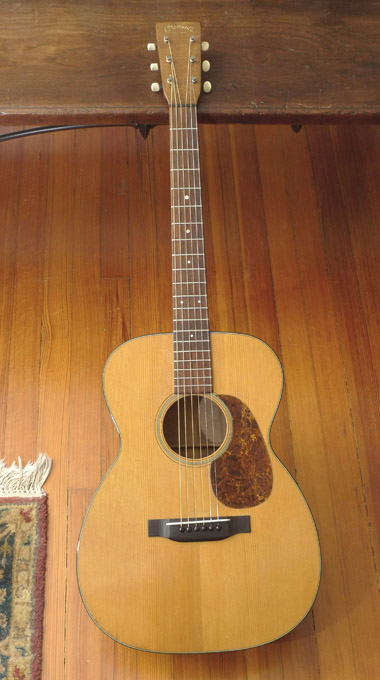 This is a prime example of why the pre-war, scalloped brace Martins made in 1943 in particular are the best sounding Martins ever: the ebony truss rod in the neck (instead of a metal truss rod– due to wartime metal rationing), the even more finely scalloped tone bars, and lack of metal tuner post bushings, all contribute to the lightness of build, and the robust tone, resonance and sustain you won’t find on any other Martin (not even the mid-30’s Martins). This guitar, seemingly light as a feather, plays like a dream, and is particularly resonant, and wonderful, for fingerpicking. (Martins from this year, often have a thinner finish, as does this one, which also contributes to its almost Shaker-like simplicity and beauty.) All original finish still in great shape. It has just had a new, Brazilian rosewood bridge made (from 100 year old, old-growth Brazilian rosewood, to the exact shape and footprint of the original which had a crack and was better replaced) by Tony Nobles (original bridge will ship, in the case). The bridge is hide-glued on, naturally. Aside from the typical B-string area “pickguard crack”, now well repaired and a non-issue, the top of the guitar is crack free. There is one well-repaired crack on the back. There was an old input jack right below the end pin, now filled expertly by Nobles (but no evidence of any pickups etc inside the guitar).
This is a prime example of why the pre-war, scalloped brace Martins made in 1943 in particular are the best sounding Martins ever: the ebony truss rod in the neck (instead of a metal truss rod– due to wartime metal rationing), the even more finely scalloped tone bars, and lack of metal tuner post bushings, all contribute to the lightness of build, and the robust tone, resonance and sustain you won’t find on any other Martin (not even the mid-30’s Martins). This guitar, seemingly light as a feather, plays like a dream, and is particularly resonant, and wonderful, for fingerpicking. (Martins from this year, often have a thinner finish, as does this one, which also contributes to its almost Shaker-like simplicity and beauty.) All original finish still in great shape. It has just had a new, Brazilian rosewood bridge made (from 100 year old, old-growth Brazilian rosewood, to the exact shape and footprint of the original which had a crack and was better replaced) by Tony Nobles (original bridge will ship, in the case). The bridge is hide-glued on, naturally. Aside from the typical B-string area “pickguard crack”, now well repaired and a non-issue, the top of the guitar is crack free. There is one well-repaired crack on the back. There was an old input jack right below the end pin, now filled expertly by Nobles (but no evidence of any pickups etc inside the guitar).- Original bridge plate, in fine condition. Original Frets.
- Original tuners (it looks like at one point there were other tuners on the guitar… with a few old screw holes filled.)
- Has never had strap lug attached to heel
- Top shows no “bellying”. Natural shape and slight arch is textbook perfect.
-
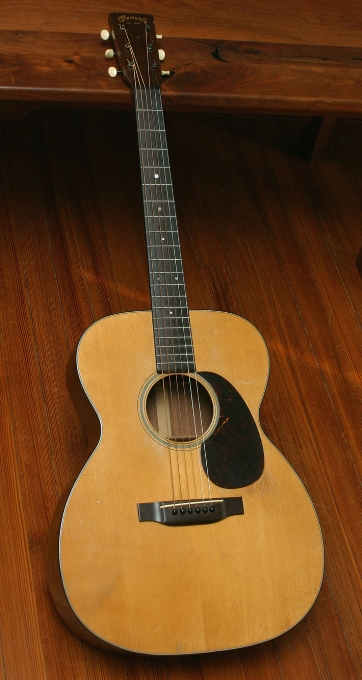 A rare, 100% original pre-war Martin. Not a crack anywhere. And though it of course has the 1-11/16 inch nut, it plays remarkably like the wider nut mid-30's 000-18's due to the generous (original) string spacing at the nut. Original finish. Neck has never been re-set. Original Ebony nut, ivory saddle, full height original bridge. Original tuners. Original plastic tuner buttons in great condition (no shrinkage). Lack of tuner ferrels of course (because of war-time metal shortages). Brazilian rosewood bridge, fingerboard, and peghead veneer. Scalloped braces. Original bridge plate. Frets show minor/normal wear. It shows light/normal pick wear around the soundhole (nothing anywhere near down to bare wood). Other minor superficial scratches on back, and sides. Bass tone and volume is impressive-the characteristic of war-time "pre-war" Martins, that featured more deeply scalloped braces. Many believe these more deeply scalloped braces found only in these years give them better tone than the mid-30s Martins. It does need a standard neck set. It's not egregiously out of set, action is a bit high at 12th fret. But due the originality of the instrument, original ivory saddle still hide glued-in, etc., we believe the buyer would want to set the neck to their liking. (We would be happy to set the neck for the new owner if desired, at no additional charge, after purchase.) The tone: gold standard pre-war 000-18. Loud, dark, crisp, and clear.
A rare, 100% original pre-war Martin. Not a crack anywhere. And though it of course has the 1-11/16 inch nut, it plays remarkably like the wider nut mid-30's 000-18's due to the generous (original) string spacing at the nut. Original finish. Neck has never been re-set. Original Ebony nut, ivory saddle, full height original bridge. Original tuners. Original plastic tuner buttons in great condition (no shrinkage). Lack of tuner ferrels of course (because of war-time metal shortages). Brazilian rosewood bridge, fingerboard, and peghead veneer. Scalloped braces. Original bridge plate. Frets show minor/normal wear. It shows light/normal pick wear around the soundhole (nothing anywhere near down to bare wood). Other minor superficial scratches on back, and sides. Bass tone and volume is impressive-the characteristic of war-time "pre-war" Martins, that featured more deeply scalloped braces. Many believe these more deeply scalloped braces found only in these years give them better tone than the mid-30s Martins. It does need a standard neck set. It's not egregiously out of set, action is a bit high at 12th fret. But due the originality of the instrument, original ivory saddle still hide glued-in, etc., we believe the buyer would want to set the neck to their liking. (We would be happy to set the neck for the new owner if desired, at no additional charge, after purchase.) The tone: gold standard pre-war 000-18. Loud, dark, crisp, and clear. -
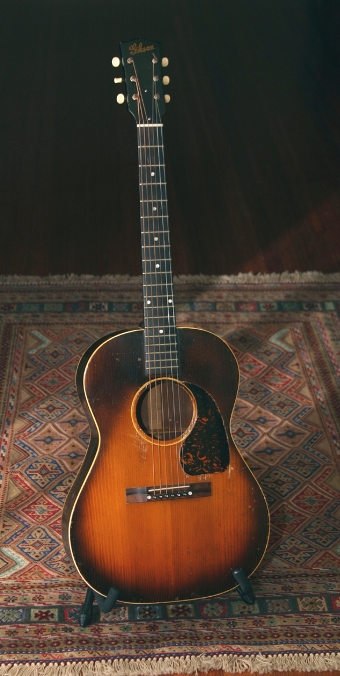 (No serial number or FON, these years often do not have one.) This completely crack-free, Script logo LG-2 is a jewel. A lot of players say the script logo Gibsons from right after the war are better sounding and better-built guitars than the Banner Gibsons. All of the good things about Banners, but with better craftsmanship. All original finish, everywhere. Mahogany back and sides. Spruce top. Not a crack anywhere. 1-3/4" nut. The bridge is an excellent quality rosewood replacement. Original maple plate. Original tuners. Replaced nut and saddle. Rosewood fingerboard shows moderate wear on first couple of frets. Some of that wonderful Gibson 40’s crazing to the finish, but not at all out of hand. Various pick marks, and dings. Original tuners, bridge, plate. Piezo pickup was skillfully de-installed, and endpin jack removed and plugged. One of the finest Script logo LG-2s you’ll find.
(No serial number or FON, these years often do not have one.) This completely crack-free, Script logo LG-2 is a jewel. A lot of players say the script logo Gibsons from right after the war are better sounding and better-built guitars than the Banner Gibsons. All of the good things about Banners, but with better craftsmanship. All original finish, everywhere. Mahogany back and sides. Spruce top. Not a crack anywhere. 1-3/4" nut. The bridge is an excellent quality rosewood replacement. Original maple plate. Original tuners. Replaced nut and saddle. Rosewood fingerboard shows moderate wear on first couple of frets. Some of that wonderful Gibson 40’s crazing to the finish, but not at all out of hand. Various pick marks, and dings. Original tuners, bridge, plate. Piezo pickup was skillfully de-installed, and endpin jack removed and plugged. One of the finest Script logo LG-2s you’ll find. -
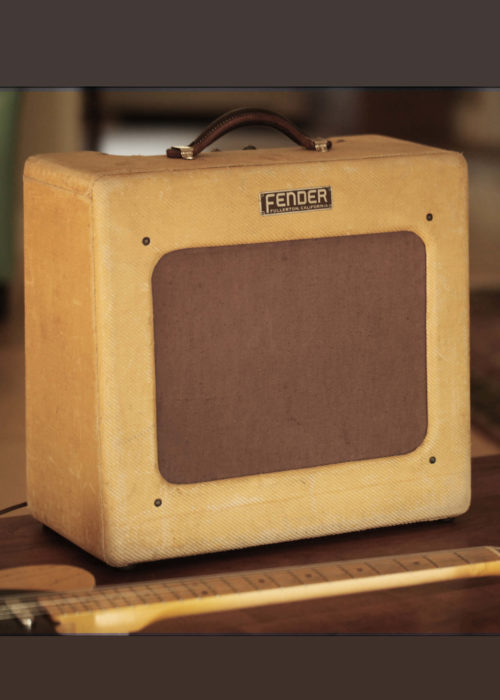 1951 Fender Deluxe Amplifier ... all it should be, and more... coming soon... . .
1951 Fender Deluxe Amplifier ... all it should be, and more... coming soon... . . -
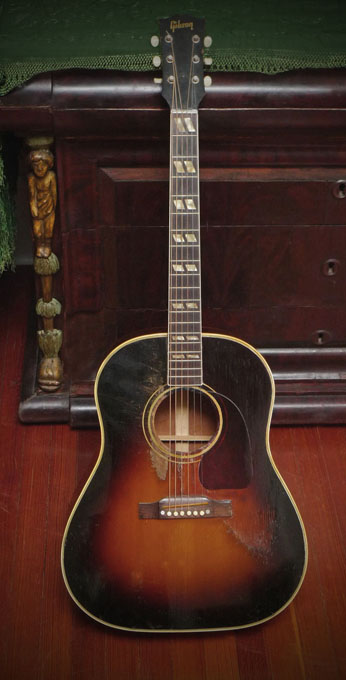 Crack-free, and superb tone. One of the finest sounding large bodied Gibsons we’ve ever heard.
Crack-free, and superb tone. One of the finest sounding large bodied Gibsons we’ve ever heard. -
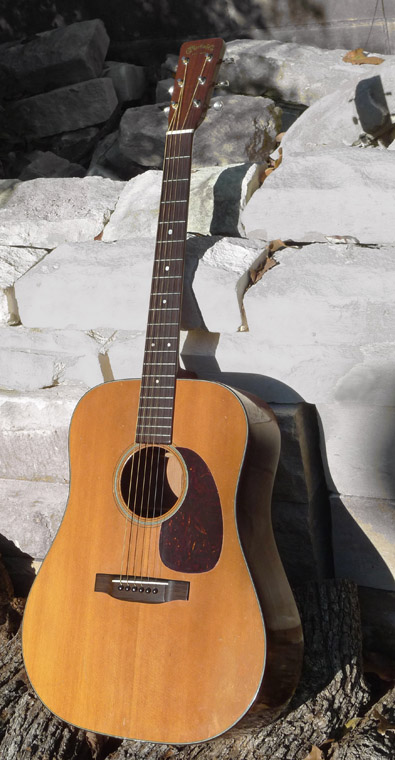 This is another great mid-fifties dread in unbelievable condition. It’s totally crack-free (also, not even a “pick guard” crack). Was acquired in 100% original condition: bridge, saddle, bridge pins, tuners, everything. Just had a neck set– resulting in great action, and tone/projection. With new condition Martin hard shell case.
This is another great mid-fifties dread in unbelievable condition. It’s totally crack-free (also, not even a “pick guard” crack). Was acquired in 100% original condition: bridge, saddle, bridge pins, tuners, everything. Just had a neck set– resulting in great action, and tone/projection. With new condition Martin hard shell case. -
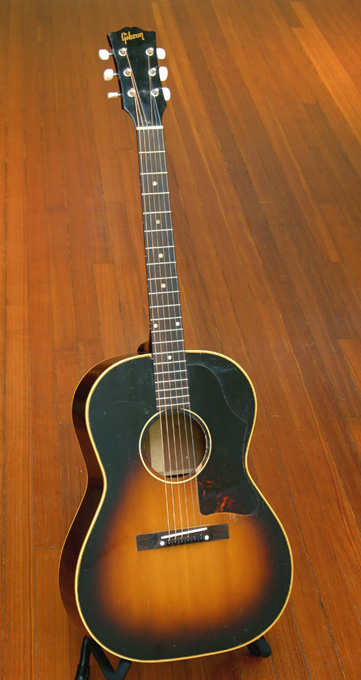 A wonderful, completely crack-free LG-2. The neck was recently set by Mark Erlewine, the frets dressed, and a new saddle installed ... beautifully set up by ME. 1-11/16 inch nut. Mahogany back and sides. Spruce top. Low action, with no buzzing. Nice sustain, and volume.
A wonderful, completely crack-free LG-2. The neck was recently set by Mark Erlewine, the frets dressed, and a new saddle installed ... beautifully set up by ME. 1-11/16 inch nut. Mahogany back and sides. Spruce top. Low action, with no buzzing. Nice sustain, and volume. -
 A chance to own a great sounding, great playing Brazilian Rosewood D-28, at a fraction of the cost of an all-original example. This D-28 has had some work, and a few issues, but it’s all repaired and ready to play. And the tone is incredible– tone you won’t find in any other mid-50’s D-28. This guitar, has just been gone over head to end pin, repaired, restored, and set up, by two of the top luthiers/repairmen in Texas, and it’s good to go for decades. The bridge is perfect. Saddle is perfect height. Action is great– low but no buzzing. It won’t need a thing. Ready to play. The tone: the scalloped braces add roundness and clarity to the basses (A and D string in particular) and a bit more “ring” to the trebles. Don’t try this at home– a scalloped braced mid 50’s D-28, but the result, set up by two of this country’s top luthiers, is a great sounding brazilian Martin dread, whose tone you won’t find in any Martin north of 1944– certainly not at this price. Here’s the report:
A chance to own a great sounding, great playing Brazilian Rosewood D-28, at a fraction of the cost of an all-original example. This D-28 has had some work, and a few issues, but it’s all repaired and ready to play. And the tone is incredible– tone you won’t find in any other mid-50’s D-28. This guitar, has just been gone over head to end pin, repaired, restored, and set up, by two of the top luthiers/repairmen in Texas, and it’s good to go for decades. The bridge is perfect. Saddle is perfect height. Action is great– low but no buzzing. It won’t need a thing. Ready to play. The tone: the scalloped braces add roundness and clarity to the basses (A and D string in particular) and a bit more “ring” to the trebles. Don’t try this at home– a scalloped braced mid 50’s D-28, but the result, set up by two of this country’s top luthiers, is a great sounding brazilian Martin dread, whose tone you won’t find in any Martin north of 1944– certainly not at this price. Here’s the report:- sometime decades ago, the top braces were scalloped
- probably as a result of a minor impact at the end pin (guitar dropped), there were cracks in the sides, and a slight crack to the neck block. So a previous luthier, long before we acquired the guitar, put in 4 small wood dowels, through the sides–near the heel, into the block (see photos). All is stable. Not the prettiest solution, but it works well.
- Small crack in heel, repaired and stable
- Original finish, on Sitka Spruce top; Oversprayed back, sides, and neck (but back of neck finish has worn, giving a natural, comfortable feel)
- A bit of damage to one corner of the headstock. But there are no cracks in headstock.
- Pickup jack installed years ago at end pin; no pickup inside; Also, an old pickup jack on bass side of guitar, filled.
- Some pickwear loss, bottom edge of soundhole
- Top of guitar has no serious cracks. No "B string" pickguard crack. Tiny crack along the treble edge of the pick guard. A couple more finish type of cracks that do not go through the wood to inside.
- Several side cracks, all addressed.
- Back of guitar has no cracks through the wood. A couple of finish cracks.
- neck set, by John Allison
- Refret, by John Allison
- New, 100% period correct, ebony bridge, made and installed by John Allison. Bridge is made to the exact specs, footprint, etc, of an original 1956 Martin bridge. A small area of finish around an older oversized bridge was addressed by John (you can see this in the photos).
- New, period correct Maple bridge plate, installed by Tony Nobles
- Old pickup jack on bass side of guitar, filled by Tony Nobles.
- The wonderful, original gold-plated Kluson waffle-back tuners, are original, and work perfectly.
- Original pickguard
- Original Martin logo on headstock
-
Out of stock
 1957 Martin D-18 Guitar with Original Red Spruce Top Read the full description below. If you're interested in this guitar, please call 512.922.8596 or contact us here.
1957 Martin D-18 Guitar with Original Red Spruce Top Read the full description below. If you're interested in this guitar, please call 512.922.8596 or contact us here. -
Out of stock
 1957 Martin D-18 Guitar with Original Red Spruce Top. Read the full description below. If you're interested in this guitar, please call 512.922.8596 or contact us here.
1957 Martin D-18 Guitar with Original Red Spruce Top. Read the full description below. If you're interested in this guitar, please call 512.922.8596 or contact us here. -
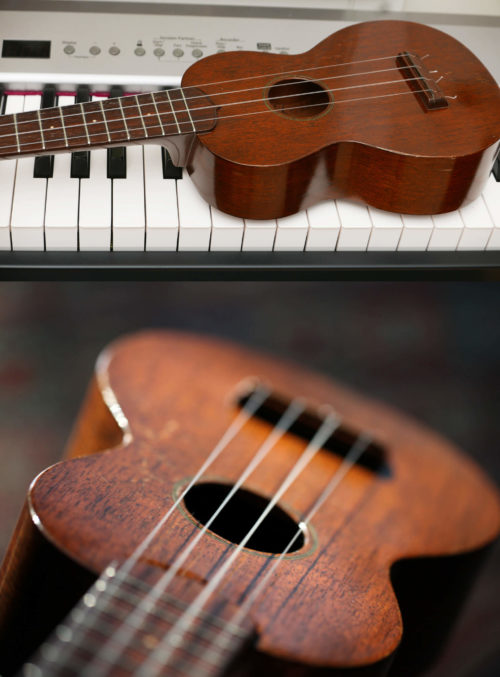 This is great example of Martin’s post war, 1950’s style 0 Ukulele. It has a few nicks and dings, but it’s 100% crack free. And it’s in its original case. It was made between 1957 and 1960 (as indicated by the tuners, and the lack of the “Made in U.S.A.”). Price: $995.
This is great example of Martin’s post war, 1950’s style 0 Ukulele. It has a few nicks and dings, but it’s 100% crack free. And it’s in its original case. It was made between 1957 and 1960 (as indicated by the tuners, and the lack of the “Made in U.S.A.”). Price: $995. -
 A wonderfully balanced and resonant Martin 00-28G, with some of the most beautiful Brazilian rosewood you’ll see on any Martin guitar, and in wonderful, crack-free, original condition. The Martin “G” is very different from the “C”. The “C” has the Martin 12 fret body. The “G” model used the 14-fret style body shape, but with the 12 fret neck, slotted headstock, and 25.4 inch scale. The 00-28G was first produced by Martin in 1936, and was discontinued in 1962, when Martin went to all “C” style for nylon string guitars. The 00-28G was Martin’s top of line model for nylon strings, from 1936, to 1962… and this guitar is the best example available on the market. The condition on this instrument is superb. No cracks anywhere, and very little wear at all... it's almost perfect. All original, tuners, nut, bridge, saddle, etc. Neck is perfect, has never been set, and shows perfect set up and action.
A wonderfully balanced and resonant Martin 00-28G, with some of the most beautiful Brazilian rosewood you’ll see on any Martin guitar, and in wonderful, crack-free, original condition. The Martin “G” is very different from the “C”. The “C” has the Martin 12 fret body. The “G” model used the 14-fret style body shape, but with the 12 fret neck, slotted headstock, and 25.4 inch scale. The 00-28G was first produced by Martin in 1936, and was discontinued in 1962, when Martin went to all “C” style for nylon string guitars. The 00-28G was Martin’s top of line model for nylon strings, from 1936, to 1962… and this guitar is the best example available on the market. The condition on this instrument is superb. No cracks anywhere, and very little wear at all... it's almost perfect. All original, tuners, nut, bridge, saddle, etc. Neck is perfect, has never been set, and shows perfect set up and action. -
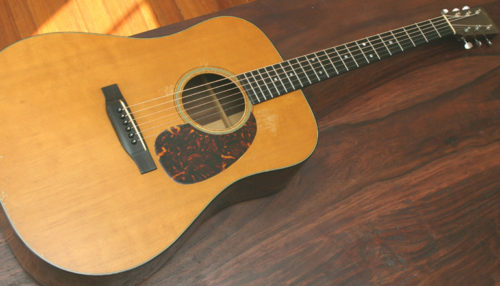 This big booming dreadnaught from one of Martin’s finest eras has everything you’d expect in volume, but it also has that wonderful sustain and ringing treble, and warm round bass, that only an almost-50-year-old Brazilian Rosewood Martin dreadnaught brings. All original throughout. Small 3 inch finish crack on lower back, stable. Typical B-string/pickguard crack, difficult to see, from bridge to beneath guard. Great original finish with minor dings and some minor pickwear around the soundhole. Ivory nut, full, original bridge and perfect condition maple bridge plate. The frets are in great condition. Rosewood fingerboard shows slight wear, nothing out of the ordinary. Frets are fine, showing minimal wear. Beautiful tortoiseshell binding in great condition, no separation anywhere. Inside of guitar shows all braces perfect–very clean and dust-free inside. Strap lug on heel and endpin. The neck was just set by Tony Nobles, and the action is low, with no buzzing. You can play it hard. It was fitted with a new bone saddle with the neck set (the original ivory saddle is in the case). Brazilian rosewood D-size Martins, from the era when Martin still used hide glue for guitar construction, are highly sought-after. This one, in this condition, will go quickly.
This big booming dreadnaught from one of Martin’s finest eras has everything you’d expect in volume, but it also has that wonderful sustain and ringing treble, and warm round bass, that only an almost-50-year-old Brazilian Rosewood Martin dreadnaught brings. All original throughout. Small 3 inch finish crack on lower back, stable. Typical B-string/pickguard crack, difficult to see, from bridge to beneath guard. Great original finish with minor dings and some minor pickwear around the soundhole. Ivory nut, full, original bridge and perfect condition maple bridge plate. The frets are in great condition. Rosewood fingerboard shows slight wear, nothing out of the ordinary. Frets are fine, showing minimal wear. Beautiful tortoiseshell binding in great condition, no separation anywhere. Inside of guitar shows all braces perfect–very clean and dust-free inside. Strap lug on heel and endpin. The neck was just set by Tony Nobles, and the action is low, with no buzzing. You can play it hard. It was fitted with a new bone saddle with the neck set (the original ivory saddle is in the case). Brazilian rosewood D-size Martins, from the era when Martin still used hide glue for guitar construction, are highly sought-after. This one, in this condition, will go quickly. -
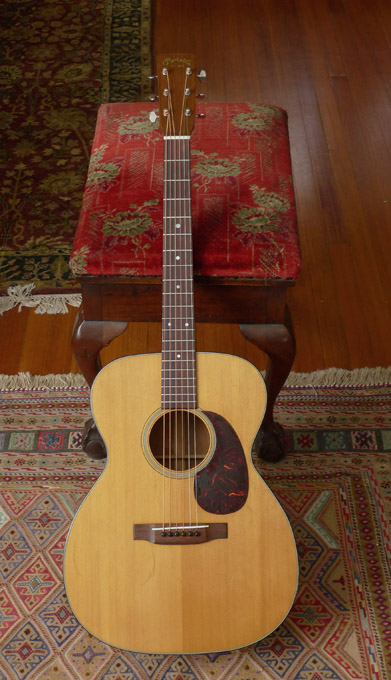 This ’63 000-18 has wonderful tone. It compares favorably to any post-war 000-18 we’ve played.
This ’63 000-18 has wonderful tone. It compares favorably to any post-war 000-18 we’ve played.- All original finish, everywhere
- The guitar is crack-free. Not even a pickguard crack.
- Original Brazilian Rosewood bridge, full height. It has never been off
- original saddle as well
- Original tuners (Grover)
- Original Ivory nut
- Original bridge plate… in perfect condition… in fact, there is not even the enlarged holes you so commonly see from the ball ends of strings working through… it’s a great original small Maple bridge plate…
- Original endpin
- There is some pick wear, and some typical crazing that 60’s Martins all have
- Frets are in good shape. The first several positions show some wear… but not a lot… it does not need new frets.
-
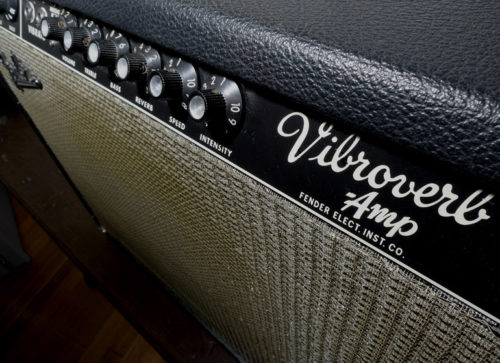 The blackface Vibroverb may be the most sought after Fender amp of all time. Stevie Ray Vaughan is famous for using them. The Vibroverb started as a 2x10 combo with reverb in '63. Then in late '63, Fender decided to switch to a 1x15. This amp has incredible tone. One must hear a black face circuit through an open cabinet JBL 15" speaker to understand the sound. It sounds big and can fill the hall, but it can work as a mid size amp perfect for gigs. This amp is versatile, since the JBL D130 can carry the treble of a telecaster or strat while still having a strong bottom end. Most other amps are either good on highs (Vibrolux, Princeton, Champ), good on lows (Twin, Showman), midrangy (Deluxe, and most new amps) or too big (Marshall double stack). The great Vibroverb is superior to them all. This 1964 Blackface Vibroverb has the original JBL speaker, and the original transformer. The amp also comes with its original footswitch. The only thing done to the amp has been replaced tubes, and the caps. The power cord has been replaced with a grounded three-prong cord.
The blackface Vibroverb may be the most sought after Fender amp of all time. Stevie Ray Vaughan is famous for using them. The Vibroverb started as a 2x10 combo with reverb in '63. Then in late '63, Fender decided to switch to a 1x15. This amp has incredible tone. One must hear a black face circuit through an open cabinet JBL 15" speaker to understand the sound. It sounds big and can fill the hall, but it can work as a mid size amp perfect for gigs. This amp is versatile, since the JBL D130 can carry the treble of a telecaster or strat while still having a strong bottom end. Most other amps are either good on highs (Vibrolux, Princeton, Champ), good on lows (Twin, Showman), midrangy (Deluxe, and most new amps) or too big (Marshall double stack). The great Vibroverb is superior to them all. This 1964 Blackface Vibroverb has the original JBL speaker, and the original transformer. The amp also comes with its original footswitch. The only thing done to the amp has been replaced tubes, and the caps. The power cord has been replaced with a grounded three-prong cord. -
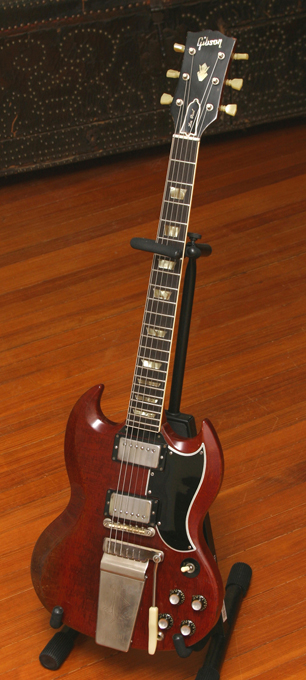 1963 and 1964 were the best years for the legendary early 60's Gibson SG. And 63-64 saw the transition from the Les Paul model to the "Solid Guitar" or SG. Only in 63 and 64 did Gibson use a particularly wide neck on the SG, and that's why players love SG's from these two seminal years. This '64 SG is something of a transition model from the last of the double cutaway Les Paul/SG's to the SG Standard-it carries the Les Paul truss rod cover (original to the guitar), and it features the great lyre vibrola (nickel). This 1964 SG, with all original finish, and original parts (including Patent # humbuckers), is a wonderful instrument with the right amount of honest wear to make it fit like a glove, and play like a dream in your left hand with that wonderful ample neck.
1963 and 1964 were the best years for the legendary early 60's Gibson SG. And 63-64 saw the transition from the Les Paul model to the "Solid Guitar" or SG. Only in 63 and 64 did Gibson use a particularly wide neck on the SG, and that's why players love SG's from these two seminal years. This '64 SG is something of a transition model from the last of the double cutaway Les Paul/SG's to the SG Standard-it carries the Les Paul truss rod cover (original to the guitar), and it features the great lyre vibrola (nickel). This 1964 SG, with all original finish, and original parts (including Patent # humbuckers), is a wonderful instrument with the right amount of honest wear to make it fit like a glove, and play like a dream in your left hand with that wonderful ample neck. -
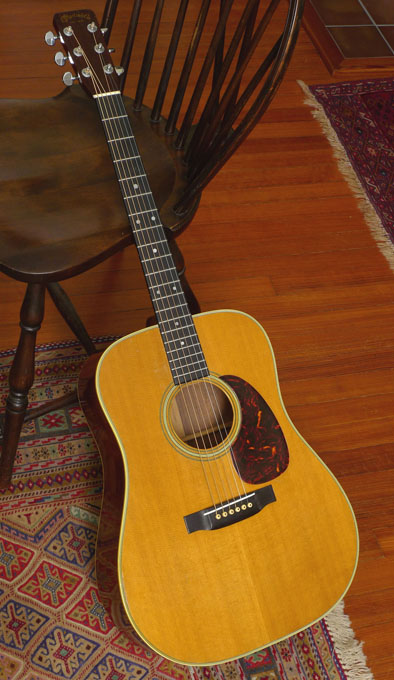 This Brazilian Rosewood D-28 dreadnaught from one of Martin’s finest eras, is special. Its structural integrity, and originality, are rare. And it’s one of the last Martin D-28’s made when Martin still used hide glue for guitar construction. This is a one-owner guitar, still in its original case. When we acquired it, it had not been played for years. Its original bridge, had a split in it, and had come loose from the top. Thus, it sat unplayed in its case for years. But all the wood beneath the bridge was pristine, perfect. So John Allison just made and installed a new exact reproduction bridge, from dark African ebony. It’s perfect, using the exact footprint of the original. The new bridge was attached with hide glue. And we used the original bridge pins.
This Brazilian Rosewood D-28 dreadnaught from one of Martin’s finest eras, is special. Its structural integrity, and originality, are rare. And it’s one of the last Martin D-28’s made when Martin still used hide glue for guitar construction. This is a one-owner guitar, still in its original case. When we acquired it, it had not been played for years. Its original bridge, had a split in it, and had come loose from the top. Thus, it sat unplayed in its case for years. But all the wood beneath the bridge was pristine, perfect. So John Allison just made and installed a new exact reproduction bridge, from dark African ebony. It’s perfect, using the exact footprint of the original. The new bridge was attached with hide glue. And we used the original bridge pins.- Guitar is 100% crack-free (no, not even a pickguard crack)
- 100% original finish, everywhere. No overspray or finish alterations of any kind. Minor dings and some minor pickwear around the soundhole.
- Has never had a strap lug attached
- Perfect condition maple bridge plate
- Original frets are in great condition
- Action is great, with just the right amount of saddle, and neck angle is perfect